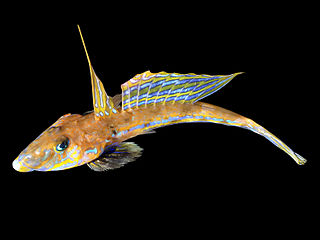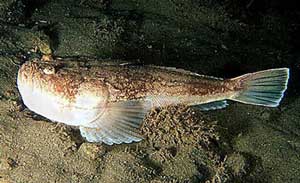
The cutlassfishes are about 45 species of predatory ray-finned fish in the family Trichiuridae of the order Scombriformes found in seas throughout the world. Fish of this family are long, slender, and generally steely blue or silver in colour, giving rise to their name. They have reduced or absent pelvic and caudal fins, giving them an eel-like appearance, and large fang-like teeth.

Ophichthidae is a family of fish in the order Anguilliformes, commonly known as the snake eels. The term "Ophichthidae" comes from Greek ophis ("serpent") and ichthys ("fish"). Snake eels are also burrowing eels. They are named for their physical appearance, as they have long, cylindrical, snake-like bodies. This family is found worldwide in tropical to warm temperate waters. They inhabit a wide range of habitats, from coastal shallows and even rivers, to depths below 800 m (2,600 ft). Most species are bottom dwellers, hiding in mud or sand to capture their prey of crustaceans and small fish, but some are pelagic.

Sargocentron is a genus of squirrelfish found in tropical parts of the Indian, Pacific and Atlantic Oceans, with the greatest species diversity near reefs in the Indo-Pacific. Being largely or entirely nocturnal, they have relatively large eyes. Red and silvery colours dominate. The preopercle spines are venomous and can give painful wounds. Most have a maximum length of 15–25 cm (6–10 in), but S. iota barely reaches 8 cm (3 in), and S. spiniferum can reach more than 50 cm (20 in).

Platycephalus is a genus of mostly marine, demersal ray-finned fish belonging to the family Platycephalidae. They are found in the eastern Mediterranean, the Indian Ocean and western Pacific Ocean.

Sillago is a genus of fish in the family Sillaginidae and the only non-monotypic genus in the family. Distinguishing the species can be difficult, with many similar in appearance and colour, forcing the use of swim bladder morphology as a definitive feature. All species are benthic in nature and generally coastal fish, living in shallow, protected waters although there are exceptions. Minor fisheries exist around various species of Sillago, making them of minor importance in most of their range. This genus has the widest distribution of any smelt-whiting genus, spanning much of the Indo-Pacific. The genus ranges from the east coast of Africa to Japan in the east and Southern Australia in the south, with most species concentrated around South East Asia, the Indonesian Archipelago and Australia. Many species have overlapping distribution, often making positive identification hard.

Callionymus is a genus of dragonets found mostly in the Indian and Pacific oceans with a few species occurring in the Atlantic Ocean.

Plectropomus, commonly known as the coral groupers, is a genus of marine ray-finned fish, groupers from the subfamily Epinephelinae, part of the family Serranidae, which also includes the anthias and sea basses. They are found in the Indo-Pacific region.

Cynoglossus is a genus of fish in the family Cynoglossidae. Most species are indigenous to the Indo-Pacific region, but there are also a few in warmer parts of the East Atlantic. They are commonly found in shallow waters on a muddy or sandy bottom, including estuaries and a few species are restricted to fresh water. One species Cynoglossus sinusarabici has invaded the Mediterranean Sea through the Suez Canal from the Red Sea, a process known as Lessepsian or Erythrean migration.

Diplodus sargus, the sargo, common white seabream, or white seabream is a species of marine ray-finned fish belonging to the family Sparidae, which includes the seabreams and porgies. This fish is found in the eastern Atlantic Ocean and in the Mediterranean Sea. It is a target species for commercial fisheries and is grown in aquaculture. D. sargussensu lato was formerly thought to be a widespread species in the eastern Atlantic and western Indian Oceans but the taxa outside of D, sargussensu stricto are now recognised as valid species and are part of the D. sargus species complex.

The roving coral grouper, also known as the spotted coral grouper, is a species of marine ray-finned fish, a grouper from the subfamily Epinephelinae which is part of the family Serranidae, which also includes the anthias and sea basses. It is found in the Indo-Pacific, although the Red Sea taxon, P. marisrubri, is regarded as a separate species by some authorities.

Dysomma is a genus of marine ray-finned fishes belonging to the family Synaphobranchidae, the cutthroat eels. These eels are found in the Atlantic, Indian and Pacific Oceans.

Uranoscopus is a genus of stargazer fish from the family Uranoscopidae. The name Uranoscopus is from the Greek, ouranos, "sky" and skopein, "to watch".

Diplodus is a genus of marine ray-finned fish belonging the family Sparidae, which includes the seabreams and porgies. These fishes are found in the Atlantic Ocean, the Mediterranean Sea and the western Indian Ocean.

The scaldfishes comprise a genus, Arnoglossus, of lefteye flounders. They are found in the Pacific, Indian and Atlantic Oceans, including the Mediterranean and Black Sea. They are entirely absent from most of the Americas; the only exceptions are A. coeruleosticta and A. multirastris found off Chile. The genus include both species found in shallow and deeper water. The largest species reaches 28 cm (11 in).

Ostichthys is a genus of fish in the family Holocentridae found in Atlantic, Indian and Pacific Ocean.

Acropoma is a genus of ray-finned fish in the family Acropomatidae, the temperate ocean-basses or lanternbellies. They are native to the Indian Ocean and western Pacific Ocean. They are characterized by a ventral luminous organ that has a luminous gland, a lens, and a reflector. The shape of the luminous organ helps distinguish the species in the genus.

Emmelichthys is a genus of marine ray-finned fishes belonging to the family Emmelichthyidae, the rovers and bonnetmouths. The species in this genus are found in the Atlantic, Indian and Pacific Oceans.

Evoxymetopon is a genus of cutlassfish found in all oceans. It is one of nine genera in the family Trichiuridae.
Ancoracysta is a genus of eukaryotic microbes containing the species Ancoracysta twista, a predatory protist that appears to be related to Haptista.

Limnichthys fasciatus, the barred sand burrower, is a species of sandburrower. It is noted for its highly developed eyes, with a structure similar to the eyes of a chameleon, which has led it to be described as marine chameleon. Its fully grown length measures between 20 millimetres (0.79 in) and 40 millimetres (1.6 in). The species is native to reefs in the Indo-Pacific. The fish preys on plankton prey by surprise attacking it from a hiding in loose sand, with only the eyes protruding from the sand.



















